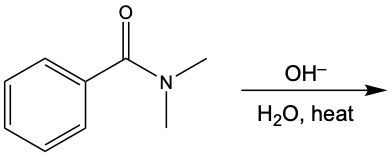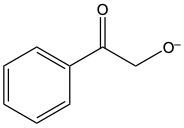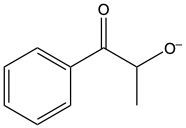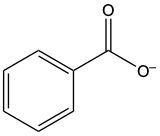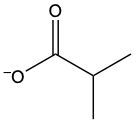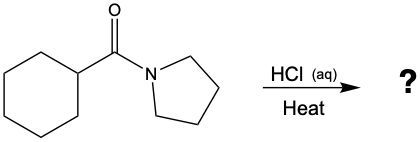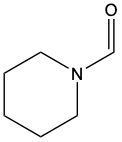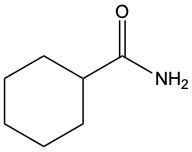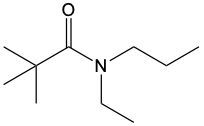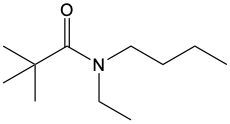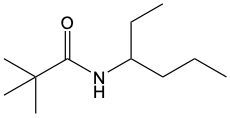Hey, everyone. So we're going to take a look at acidic hydrolysis of amides. Now we're going to say that under this reaction, an amide is hydrolyzed into a carboxylic acid and an ammonium ion in an acidic medium. Now if we take a look at this general reaction, we have our amide here and with it our amide bond that connects our nitrogen to our carbonyl group. Under this reaction, we use basically aqueous acid, meaning that we have hydrochloric acid dissolved in water, and we accompany it with heat. Basically what happens is that in this reaction, the carbonyl carbon is going to gain a hydroxyl group. Doing this transforms it into a carboxylic acid. And at the same time, we're going to have the nitrogen itself gains 2 hydrogen atoms, and thereby becomes an ammonium ion. Remember when nitrogen makes 4 bonds it becomes positively charged. It transitions from being a neutral amine to an ammonium ion. So just remember under acidic hydrolysis we make a carboxylic acid and an ammonium ion.
- 1. Matter and Measurements4h 29m
- What is Chemistry?5m
- The Scientific Method9m
- Classification of Matter16m
- States of Matter8m
- Physical & Chemical Changes19m
- Chemical Properties8m
- Physical Properties5m
- Intensive vs. Extensive Properties13m
- Temperature (Simplified)9m
- Scientific Notation13m
- SI Units (Simplified)5m
- Metric Prefixes24m
- Significant Figures (Simplified)11m
- Significant Figures: Precision in Measurements7m
- Significant Figures: In Calculations19m
- Conversion Factors (Simplified)15m
- Dimensional Analysis22m
- Density12m
- Specific Gravity9m
- Density of Geometric Objects19m
- Density of Non-Geometric Objects9m
- 2. Atoms and the Periodic Table5h 23m
- The Atom (Simplified)9m
- Subatomic Particles (Simplified)12m
- Isotopes17m
- Ions (Simplified)22m
- Atomic Mass (Simplified)17m
- Atomic Mass (Conceptual)12m
- Periodic Table: Element Symbols6m
- Periodic Table: Classifications11m
- Periodic Table: Group Names8m
- Periodic Table: Representative Elements & Transition Metals7m
- Periodic Table: Elemental Forms (Simplified)6m
- Periodic Table: Phases (Simplified)8m
- Law of Definite Proportions9m
- Atomic Theory9m
- Rutherford Gold Foil Experiment9m
- Wavelength and Frequency (Simplified)5m
- Electromagnetic Spectrum (Simplified)11m
- Bohr Model (Simplified)9m
- Emission Spectrum (Simplified)3m
- Electronic Structure4m
- Electronic Structure: Shells5m
- Electronic Structure: Subshells4m
- Electronic Structure: Orbitals11m
- Electronic Structure: Electron Spin3m
- Electronic Structure: Number of Electrons4m
- The Electron Configuration (Simplified)22m
- Electron Arrangements5m
- The Electron Configuration: Condensed4m
- The Electron Configuration: Exceptions (Simplified)12m
- Ions and the Octet Rule9m
- Ions and the Octet Rule (Simplified)8m
- Valence Electrons of Elements (Simplified)5m
- Lewis Dot Symbols (Simplified)7m
- Periodic Trend: Metallic Character4m
- Periodic Trend: Atomic Radius (Simplified)7m
- 3. Ionic Compounds2h 18m
- Periodic Table: Main Group Element Charges12m
- Periodic Table: Transition Metal Charges6m
- Periodic Trend: Ionic Radius (Simplified)5m
- Periodic Trend: Ranking Ionic Radii8m
- Periodic Trend: Ionization Energy (Simplified)9m
- Periodic Trend: Electron Affinity (Simplified)8m
- Ionic Bonding6m
- Naming Monoatomic Cations6m
- Naming Monoatomic Anions5m
- Polyatomic Ions25m
- Naming Ionic Compounds11m
- Writing Formula Units of Ionic Compounds7m
- Naming Ionic Hydrates6m
- Naming Acids18m
- 4. Molecular Compounds2h 18m
- Covalent Bonds6m
- Naming Binary Molecular Compounds6m
- Molecular Models4m
- Bonding Preferences6m
- Lewis Dot Structures: Neutral Compounds (Simplified)8m
- Multiple Bonds4m
- Multiple Bonds (Simplified)6m
- Lewis Dot Structures: Multiple Bonds10m
- Lewis Dot Structures: Ions (Simplified)8m
- Lewis Dot Structures: Exceptions (Simplified)12m
- Resonance Structures (Simplified)5m
- Valence Shell Electron Pair Repulsion Theory (Simplified)4m
- Electron Geometry (Simplified)8m
- Molecular Geometry (Simplified)11m
- Bond Angles (Simplified)11m
- Dipole Moment (Simplified)15m
- Molecular Polarity (Simplified)7m
- 5. Classification & Balancing of Chemical Reactions3h 17m
- Chemical Reaction: Chemical Change5m
- Law of Conservation of Mass5m
- Balancing Chemical Equations (Simplified)13m
- Solubility Rules16m
- Molecular Equations18m
- Types of Chemical Reactions12m
- Complete Ionic Equations18m
- Calculate Oxidation Numbers15m
- Redox Reactions17m
- Spontaneous Redox Reactions8m
- Balancing Redox Reactions: Acidic Solutions17m
- Balancing Redox Reactions: Basic Solutions17m
- Balancing Redox Reactions (Simplified)13m
- Galvanic Cell (Simplified)16m
- 6. Chemical Reactions & Quantities2h 35m
- 7. Energy, Rate and Equilibrium3h 46m
- Nature of Energy6m
- First Law of Thermodynamics7m
- Endothermic & Exothermic Reactions7m
- Bond Energy14m
- Thermochemical Equations12m
- Heat Capacity19m
- Thermal Equilibrium (Simplified)8m
- Hess's Law23m
- Rate of Reaction11m
- Energy Diagrams12m
- Chemical Equilibrium7m
- The Equilibrium Constant14m
- Le Chatelier's Principle23m
- Solubility Product Constant (Ksp)17m
- Spontaneous Reaction10m
- Entropy (Simplified)9m
- Gibbs Free Energy (Simplified)18m
- 8. Gases, Liquids and Solids3h 25m
- Pressure Units6m
- Kinetic Molecular Theory14m
- The Ideal Gas Law18m
- The Ideal Gas Law Derivations13m
- The Ideal Gas Law Applications6m
- Chemistry Gas Laws16m
- Chemistry Gas Laws: Combined Gas Law12m
- Standard Temperature and Pressure14m
- Dalton's Law: Partial Pressure (Simplified)13m
- Gas Stoichiometry18m
- Intermolecular Forces (Simplified)19m
- Intermolecular Forces and Physical Properties11m
- Atomic, Ionic and Molecular Solids10m
- Heating and Cooling Curves30m
- 9. Solutions4h 10m
- Solutions6m
- Solubility and Intermolecular Forces18m
- Solutions: Mass Percent6m
- Percent Concentrations10m
- Molarity18m
- Osmolarity15m
- Parts per Million (ppm)13m
- Solubility: Temperature Effect8m
- Intro to Henry's Law4m
- Henry's Law Calculations12m
- Dilutions12m
- Solution Stoichiometry14m
- Electrolytes (Simplified)13m
- Equivalents11m
- Molality15m
- The Colligative Properties15m
- Boiling Point Elevation16m
- Freezing Point Depression9m
- Osmosis16m
- Osmotic Pressure9m
- 10. Acids and Bases3h 29m
- Acid-Base Introduction11m
- Arrhenius Acid and Base6m
- Bronsted Lowry Acid and Base18m
- Acid and Base Strength17m
- Ka and Kb12m
- The pH Scale19m
- Auto-Ionization9m
- pH of Strong Acids and Bases9m
- Acid-Base Equivalents14m
- Acid-Base Reactions7m
- Gas Evolution Equations (Simplified)6m
- Ionic Salts (Simplified)23m
- Buffers25m
- Henderson-Hasselbalch Equation16m
- Strong Acid Strong Base Titrations (Simplified)10m
- 11. Nuclear Chemistry56m
- BONUS: Lab Techniques and Procedures1h 38m
- BONUS: Mathematical Operations and Functions47m
- 12. Introduction to Organic Chemistry1h 34m
- 13. Alkenes, Alkynes, and Aromatic Compounds2h 12m
- 14. Compounds with Oxygen or Sulfur1h 6m
- 15. Aldehydes and Ketones1h 1m
- 16. Carboxylic Acids and Their Derivatives1h 11m
- 17. Amines38m
- 18. Amino Acids and Proteins1h 51m
- 19. Enzymes1h 37m
- 20. Carbohydrates1h 46m
- Intro to Carbohydrates4m
- Classification of Carbohydrates4m
- Fischer Projections4m
- Enantiomers vs Diastereomers8m
- D vs L Enantiomers8m
- Cyclic Hemiacetals8m
- Intro to Haworth Projections4m
- Cyclic Structures of Monosaccharides11m
- Mutarotation4m
- Reduction of Monosaccharides10m
- Oxidation of Monosaccharides7m
- Glycosidic Linkage14m
- Disaccharides7m
- Polysaccharides7m
- 21. The Generation of Biochemical Energy2h 8m
- 22. Carbohydrate Metabolism2h 22m
- 23. Lipids2h 26m
- Intro to Lipids6m
- Fatty Acids25m
- Physical Properties of Fatty Acids6m
- Waxes4m
- Triacylglycerols12m
- Triacylglycerol Reactions: Hydrogenation8m
- Triacylglycerol Reactions: Hydrolysis13m
- Triacylglycerol Reactions: Oxidation7m
- Glycerophospholipids15m
- Sphingomyelins13m
- Steroids15m
- Cell Membranes7m
- Membrane Transport10m
- 24. Lipid Metabolism1h 45m
- 25. Protein and Amino Acid Metabolism1h 37m
- 26. Nucleic Acids and Protein Synthesis2h 54m
- Intro to Nucleic Acids4m
- Nitrogenous Bases16m
- Nucleoside and Nucleotide Formation9m
- Naming Nucleosides and Nucleotides13m
- Phosphodiester Bond Formation7m
- Primary Structure of Nucleic Acids11m
- Base Pairing10m
- DNA Double Helix6m
- Intro to DNA Replication20m
- Steps of DNA Replication11m
- Types of RNA10m
- Overview of Protein Synthesis4m
- Transcription: mRNA Synthesis9m
- Processing of pre-mRNA5m
- The Genetic Code6m
- Introduction to Translation7m
- Translation: Protein Synthesis18m
Amide Hydrolysis - Online Tutor, Practice Problems & Exam Prep
 Created using AI
Created using AIAcidic hydrolysis of amides involves the reaction of an amide with aqueous acid, typically hydrochloric acid, under heat, resulting in a carboxylic acid and an ammonium ion. The carbonyl carbon gains a hydroxyl group, transforming into a carboxylic acid, while the nitrogen becomes positively charged by gaining two hydrogen atoms, forming an ammonium ion. In contrast, basic hydrolysis uses hydroxide ions to cleave the amide bond, producing a carboxylate anion and a neutral amine. Here, the carbonyl carbon gains an oxygen atom with a negative charge, while the nitrogen gains one hydrogen atom, resulting in a neutral amine.
Acidic Hydrolysis Concept 1
Video transcript
Acidic Hydrolysis Example 1
Video transcript
Determine the products when 3,3-dimethylhexanamide is treated with an aqueous hydrochloric acid solution. So remember, in this reaction, we're going to cut this amide bond. And what's going to occur is that the carbonyl carbon gains an OH group. So, we create a carboxylic acid. At the same time, the nitrogen itself will gain 2 hydrogen atoms. Since nitrogen already contains 2 hydrogens, it's going to gain another 2. So at the end, we'll have 4 hydrogens on the nitrogen. It'll be making 4 bonds, so it'll be positively charged. So here, we make an ammonium ion as the second product. So this would be our answer for this particular example question. We created a carboxylic acid and the ammonium ion.
Name the carboxylic acid formed when the following amide undergoes an acidic hydrolysis reaction.
2-bromopentanoic acid
3-bromohexanoic acid
3-bromopentanoic acid
3-bromohexanoate
Basic Hydrolysis Concept 2
Video transcript
In this video, we're going to take a look at basic hydrolysis of amides. Now, under this reaction, we're going to say that the hydroxide ion, which is OH-, dissolved in water reacts with an amide. The reaction cleaves or cuts the amide bond to create a carboxylate anion and an amine. Now, if we take a look here at this general reaction, we're going to cut this amide bond by using aqueous hydroxide. So that just means it's dissolved in water and accompanied by some heat.
So essentially, what happens here is that the carbonyl carbon will gain an O- because a carboxylate anion is just the conjugate base form of a carboxylic acid. So instead of having an OH group, it has an O minus group. And the nitrogen here would only gain 1 hydrogen atom. Here we create a neutral amine. So under basic conditions, we're not making a carboxylic acid, we're making its conjugate base, which is our carboxylate anion. And for the amine, it's going to be a neutral amine that's being formed.
Basic Hydrolysis Example 2
Video transcript
Determine the products when N-ethyln-methylbutanamide is treated with an aqueous hydroxide ion solution. Now, before we do this question, remember, when it comes to our N substituents, you have to have your N capitalized and italicized. Right. So that's the name of this particular amide. Now, under basic hydrolysis, we're going to cut the amide bond. When we do that, we're going to make a carboxylate anion. So the carbonyl group gets an O negative attached to it, and then the amide, well, the nitrogen part of the amide, that nitrogen, all it's going to do is gain 1 hydrogen and stay as a neutral amine. Right? So in this particular question, we make a carboxylate anion product as well as a neutral amine.
Determine the carboxylate anion formed in the following reaction between the given amide and aqueous base.
Determine the nitrogen product formed when the following amide undergoes acidic hydrolysis.
What was the starting material that created the following products?
Do you want more practice?
Here’s what students ask on this topic:
What is the mechanism of acidic hydrolysis of amides?
In acidic hydrolysis of amides, the reaction occurs in the presence of aqueous acid, typically hydrochloric acid, and heat. The carbonyl carbon of the amide gains a hydroxyl group (OH), transforming into a carboxylic acid. Simultaneously, the nitrogen atom in the amide gains two hydrogen atoms, forming an ammonium ion. The overall reaction can be summarized as:
 Created using AI
Created using AIWhat are the products of basic hydrolysis of amides?
In basic hydrolysis of amides, the reaction occurs with hydroxide ions (OH-) in water and heat. The amide bond is cleaved, resulting in the formation of a carboxylate anion and a neutral amine. The carbonyl carbon gains an oxygen atom with a negative charge (O-), forming the carboxylate anion, while the nitrogen gains one hydrogen atom, forming a neutral amine. The overall reaction can be summarized as:
 Created using AI
Created using AIHow does the acidic hydrolysis of amides differ from basic hydrolysis?
Acidic hydrolysis of amides involves the use of aqueous acid (e.g., HCl) and heat, resulting in the formation of a carboxylic acid and an ammonium ion. The carbonyl carbon gains a hydroxyl group (OH), and the nitrogen gains two hydrogen atoms, forming an ammonium ion. In contrast, basic hydrolysis uses hydroxide ions (OH-) and heat, producing a carboxylate anion and a neutral amine. The carbonyl carbon gains an oxygen atom with a negative charge (O-), and the nitrogen gains one hydrogen atom, forming a neutral amine. The key difference lies in the products: acidic hydrolysis yields a carboxylic acid and ammonium ion, while basic hydrolysis yields a carboxylate anion and a neutral amine.
 Created using AI
Created using AIWhat conditions are required for the hydrolysis of amides?
The hydrolysis of amides can occur under either acidic or basic conditions, both requiring heat. For acidic hydrolysis, an aqueous acid such as hydrochloric acid (HCl) is used. The reaction produces a carboxylic acid and an ammonium ion. For basic hydrolysis, an aqueous solution of hydroxide ions (OH-), such as sodium hydroxide (NaOH), is used. This reaction produces a carboxylate anion and a neutral amine. In both cases, heat is necessary to facilitate the reaction and ensure the amide bond is cleaved effectively.
 Created using AI
Created using AIWhy is heat necessary for the hydrolysis of amides?
Heat is necessary for the hydrolysis of amides because it provides the energy required to break the strong amide bond. The amide bond is relatively stable and requires significant energy to be cleaved. In both acidic and basic hydrolysis, heat helps to accelerate the reaction by increasing the kinetic energy of the molecules, thereby facilitating the interaction between the amide and the hydrolyzing agents (acid or base). Without sufficient heat, the reaction would proceed very slowly or might not occur at all.
 Created using AI
Created using AIYour GOB Chemistry tutor
- What carboxylic acids and amines result from hydrolysis of the following amides?a. <IMAGE>
- What carboxylic acids and amines result from hydrolysis of the following amides?b. N,N-Dimethyl-p-nitrobenzami...
- Identify the functional group in the following compounds and give the structures of the products of hydrolysis...
- N-Acetylglucosamine (also known as NAG) is an important component on the surfaces of cells.b. Draw the structu...
- When both the carboxylic acid and the amine are in the same molecule, amide formation produces lactams. A lact...
- Draw the condensed structural or line-angle formulas for the products from the hydrolysis of each of the follo...
- Draw the condensed structural or line-angle formulas for the products from the hydrolysis of each of the follo...
- Draw the condensed structural or line-angle formulas for the products from the hydrolysis of each of the follo...
- Draw the condensed structural or line-angle formulas for the products from the hydrolysis of each of the follo...
- Draw the condensed structural or line-angle formulas for the products from the hydrolysis of each of the follo...
- Draw the condensed structural or line-angle formulas for the products from the hydrolysis of each of the follo...
- Draw the condensed structural or line-angle formulas for the products from the hydrolysis of each of the follo...
- Draw the condensed structural or line-angle formulas for the products from the hydrolysis of each of the follo...

